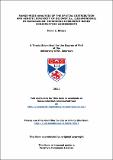Files in this item
Range-wide analysis of the spatial distribution and genetic diversity of Delonix s.l. (Leguminosae) in Madagascar : enhancing herbarium-based conservation assessments
Item metadata
| dc.contributor.advisor | Meagher, Thomas Robert | |
| dc.contributor.author | Rivers, Malin C. | |
| dc.coverage.spatial | 260 | en_US |
| dc.date.accessioned | 2011-12-08T12:03:41Z | |
| dc.date.available | 2011-12-08T12:03:41Z | |
| dc.date.issued | 2011 | |
| dc.identifier | uk.bl.ethos.552631 | |
| dc.identifier.uri | https://hdl.handle.net/10023/2097 | |
| dc.description.abstract | Despite their ecological and economic importance, the majority of plant species and their conservation status are poorly known. Only 4% of plants have been assessed globally and listed on the IUCN Red List of Threatened Species; and without plant conservation assessments, many plant species will not feature in conservation planning. Herbarium collection information can significantly increase the number of plant conservation assessments. Thus, the aims of this thesis were: (1) to investigate how the quality of herbarium-based conservation assessments can be optimised; (2) to assess the extent to which herbarium-based conservation assessments reflect the reality on the ground; and (3) to scientifically validate genetic and spatial underpinning of IUCN criteria. Preliminary range-based assessments of the Leguminosae of Madagascar achieved a result consistent with the final conservation rating for over 95% of species when using up to fifteen herbarium specimens. Bioclimatic modelling of range shifts based on future climate change predicted that, in the worst case scenario, up to one third of endemic Leguminosae in Madagascar will be threatened with extinction over the next 100 years. An analysis of the population structure of species of Delonix s.l. (Leguminosae) showed that combining spatial analysis with population genetic data provides a more complete picture of landscape-level population dynamics and the impacts on conservation status. Moreover, range-wide genetic analysis of AFLP markers for four species of Delonix demonstrated a genetic basis for IUCN categories distinguishing between threatened and non-threatened species. Although genetic data are currently not often incorporated in conservation assessments, they are crucial in making accurate management decisions and creating effective action plans for conservation. Only by using all available scientific resources can informed conservation decisions be made and the survival of plants and their associated ecosystems be ensured. | en_US |
| dc.language.iso | en | en_US |
| dc.publisher | University of St Andrews | |
| dc.rights | Creative Commons Attribution-NonCommercial-NoDerivs 3.0 Unported | |
| dc.rights.uri | http://creativecommons.org/licenses/by-nc-nd/3.0/ | |
| dc.subject.lcc | QK86.M2R5 | |
| dc.subject.lcsh | Plant conservation--Madagascar | en_US |
| dc.subject.lcsh | Endangered plants--Madagascar | en_US |
| dc.subject.lcsh | Delonix--Conservation--Madagascar | en_US |
| dc.subject.lcsh | Spatial analysis (Statistics) | en_US |
| dc.subject.lcsh | Plant population genetics | en_US |
| dc.title | Range-wide analysis of the spatial distribution and genetic diversity of Delonix s.l. (Leguminosae) in Madagascar : enhancing herbarium-based conservation assessments | en_US |
| dc.type | Thesis | en_US |
| dc.type.qualificationlevel | Doctoral | en_US |
| dc.type.qualificationname | PhD Doctor of Philosophy | en_US |
| dc.publisher.institution | The University of St Andrews | en_US |
| dc.publisher.department | Royal Botanic Gardens, Kew | en_US |
This item appears in the following Collection(s)
Except where otherwise noted within the work, this item's licence for re-use is described as Creative Commons Attribution-NonCommercial-NoDerivs 3.0 Unported
Items in the St Andrews Research Repository are protected by copyright, with all rights reserved, unless otherwise indicated.


